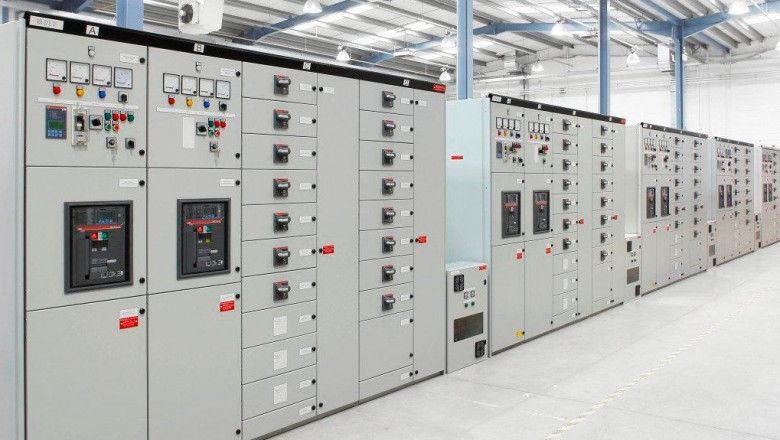views
What is an Electric Control Panel?
An electric control panel, also known as a control panel or power distribution panel, is an enclosed cabinet with switches, buttons, pilot lights, and display devices used to operate and monitor industrial machinery and processes requiring electric power. It collects and integrates various components required for controlling and monitoring industrial equipment and processes.
Components of an Electric Control Panel
An Electric Control Panel consists of various components that allow for the central control and distribution of electric power to machinery and processes. Some of the key components include:
Circuit Breakers and Fuses
Circuit breakers and fuses provide overcurrent protection for the control panel and connected equipment. Circuit breakers automatically trip and interrupt electric current flow when an overload or short circuit occurs, protecting wiring and components downstream. Fuses work in a similar manner but must be replaced after tripping instead of automatically resetting.
Contactors
Contactors are electromechanical switches used to control larger loads than can be handled directly by the control circuit. They allow circuits to be opened or closed remotely using a low-voltage control signal. Contactors are commonly used to start and stop motors and switch heavy loads on and off.
Pilot Devices
Pilot devices allow operators to monitor and control the process or equipment. Some common pilot devices found on control panels include push buttons, selector switches, indicator lights, and displays. Pushbuttons allow starting or stopping a process when pressed. Selector switches choose between operating modes. Lights provide status feedback.
Control and Monitoring Devices
Programmable logic controllers (PLCs), variable frequency drives (VFDs), temperature controllers, and other digital or analog control and monitoring devices are often incorporated into control panels. They receive input signals, perform control logic functions, and output control signals based on the logic. This allows complex automatic control and monitoring of processes.
Terminal Blocks
Terminal blocks provide connections between wiring running to and from the control panel and the internal components through numbered terminal screws. This simplifies wiring installation and maintenance by making it easy to disconnect or reconnect wires.
Enclosure
All live parts and components are housed safely within an enclosure, usually made of metal, plastic or a combination. This protects the panel and contents from dust, moisture, corrosion and accidental contact during operation. Doors or removable panels allow access for maintenance or modifications.
Applications of Electric Control Panels
Electric control panels are used in a wide variety of industrial and commercial applications to safely control electrical equipment and automate processes. Some common applications include:
Machine Control
Control panels are integrated into machinery to allow safe, automated operation through pushbuttons, selector switches and indicators. They control functions like motors, clutches, valves and solenoids. Typical machines include robots, packaging equipment, printing presses and CNC machines.
Process Control
Process control panels monitor and regulate conditions like temperature, pressure, flow and level using instrumentation. They are used in industries such as manufacturing, oil and gas, water and wastewater treatment, food and beverage processing, and chemical production.
Power Distribution
Large control panels act as motor control centers or main power distribution points. They route power from primary switchgear to secondary control panels or provide power, protection and control for entire production lines or areas.
Building Automation
Building automation systems integrate lighting, HVAC, security and other building systems through control panels. They automate functions for comfort, energy efficiency and access control in commercial facilities.
Purpose and Benefits of Control Panels
In summary, control panels provide centralized control of electrical equipment and automation of processes through the integration of components in a protected enclosure. They have several benefits including:
Safety - Electrical components are safely contained, labeled, and isolated from unintended contact. Overcurrent protection prevents damage from faults.
Reliability - Control logic resides in protected devices rather than vulnerable wiring. Standardized terminals simplify maintenance.
Control - Integrated control devices allow complex, automated operation through a single interface instead of individual components. Operators have centralized monitoring of status and control inputs.
Convenience - Numerous functions are concentrated in a compact panel instead of distributed devices and wiring, simplifying system design, installation and upgrades over time.
Cost Effectiveness - Using a control panel brings efficiency by mounting components together closely without redundant components and wiring. Modular design enables flexible expansion.
Electric control panels play a vital role in industrial automation and process control by centralizing power distribution and control functions in a safe, reliable, convenient and cost-effective manner. Their integration of protection devices, contactors, control hardware, pilot devices and terminals allows complex machinery and systems to operate through simple, standardized interfaces. As processes continue to become more advanced, control panels will remain essential for safeguarding equipment and facilitating automation.
Get More Insights On - Electric Control Panel
Get this Report in Japanese Language:
Get this Report in Korean Language:
About Author:
Vaagisha brings over three years of expertise as a content editor in the market research domain. Originally a creative writer, she discovered her passion for editing, combining her flair for writing with a meticulous eye for detail. Her ability to craft and refine compelling content makes her an invaluable asset in delivering polished and engaging write-ups.
(LinkedIn: https://www.linkedin.com/in/vaagisha-singh-8080b91)






















Comments
0 comment